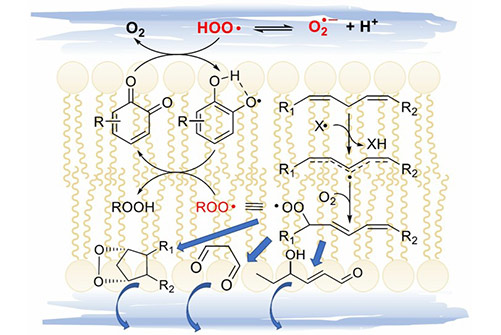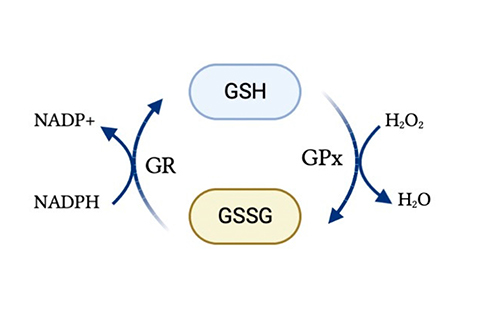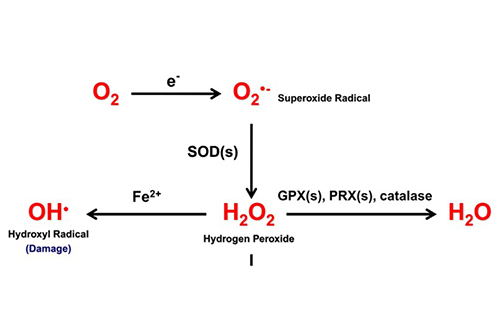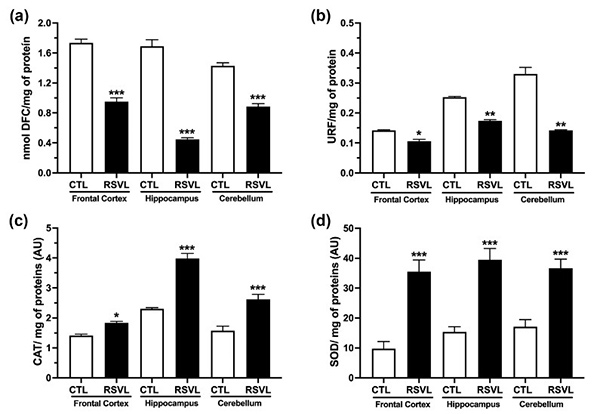Oxidative Stress Assay
Background
Oxidative stress arises when there is an imbalance between the production of reactive oxygen species (ROS) and the body's antioxidant defense systems. These ROS—including free radicals and peroxides—can damage critical biomolecules such as proteins, nucleic acids, and lipids. Over the past 40 years, oxidative stress has been recognized as a key contributor to the pathogenesis of aging and a wide range of chronic diseases, including cardiovascular disorders, neurodegeneration, cancer, and metabolic syndrome.
To advance research and drug discovery in this vital area, Creative BioMart offers robust, accurate Oxidative Stress Assay Services designed to quantify and characterize oxidative damage and antioxidant capacity in biological samples.
What We Offer?
Service Procedure

Service Details
|
Type |
 Lipid Peroxidation Analysis |
 Glutathione (GSH) Analysis |
 Custom Assays Available |
|
Purpose |
Measures peroxidation of membrane lipids, a primary marker of oxidative stress. |
Quantifies reduced glutathione, a major intracellular antioxidant. |
We also support ROS detection via general and selective fluorescent indicators, protein oxidation markers, and DNA oxidation endpoints (e.g., 8-OHdG). |
|
Indicators/Method |
Malondialdehyde (MDA), 4-hydroxyalkenals. |
Measures total, reduced (GSH), and oxidized (GSSG) forms. |
|
|
Applications |
Assess cellular injury and oxidative degradation of polyunsaturated fatty acids. |
Evaluate antioxidant capacity and redox balance in cells and tissues. |
Why Choose Us?
- Comprehensive Platform: We offer a full panel of oxidative stress assays for lipids, proteins, and nucleic acids.
- High Sensitivity & Specificity: Utilizing state-of-the-art detection methods for highly accurate ROS and antioxidant quantification.
- Expert Support: Work with scientists who specialize in redox biology and have deep experience in assay development.
- Customizable Solutions: Flexible options for assay format, sample type, and detection readout (colorimetric, fluorometric, or chemiluminescent).
- Fast Turnaround: Rapid processing and results reporting to meet your project timelines.
- Validated Across Models: Robust performance in cell-based, tissue, and biochemical systems.
Case Study
* NOTE: We prioritize confidentiality to safeguard our clients’ technology and intellectual property. As an alternative, we present selected published research articles as representative case studies. For details on the assay services and products used in these studies, please refer to the relevant sections of the cited literature.
Case 1: Validation of a flow cytometric assay to detect intraerythrocytic reactive oxygen species in horses
Serpa et al., 2021. doi:10.1111/vcp.12976
This study aimed to validate a flow cytometry method using DCFH-DA to detect reactive oxygen species (ROS) inside red blood cells (erythrocytes) of healthy horses. Since traditional ROS detection methods are often expensive and indirect, the researchers tested DCFH-DA, which fluoresces when oxidized by ROS, offering a more straightforward and cost-effective alternative. They incubated horse erythrocytes with DCFH-DA, both with and without hydrogen peroxide stimulation, and measured fluorescence to assess ROS levels. The method showed strong precision (low variation), good stability, and clear differentiation between stimulated and unstimulated cells. These results suggest the assay is a reliable and practical tool for studying oxidative stress in equine red blood cells.

Figure 1. Logarithmic forward (FSC- A) and side scatter plots (SSC-A) showing the gating strategy using one representative sample. (A) Depiction of all gates, where grey represents leukocytes, red, erythrocytes, and blue, platelets. (B) Platelet-rich plasma sample, containing mainly platelets. (C) Buffy coat sample containing leukocytes and most likely platelets and remaining erythrocytes. (D) Erythrocyte sample, containing mainly erythrocytes and small numbers of remaining platelets and leukocytes. (Serpa et al., 2022)
Case 2: Chronic resveratrol administration reduces oxidative stress and brain cell loss and improves memory of recognition in old rats
Juarez et al., 2023. doi:10.1002/syn.22271
As people age, brain structure and function decline, leading to cognitive and motor impairments. This study explored whether chronic treatment with resveratrol (RSVL)—a potent antioxidant found in red fruits and wine—could counteract these effects in aged rats. Researchers assessed brain oxidative stress, cell loss, and behavior in 20-month-old rats treated with RSVL. The results were promising: RSVL-treated rats showed better recognition memory and motor activity, reduced oxidative damage, and enhanced antioxidant system activity. Histological analysis also revealed that RSVL helped preserve brain cells in key regions. Overall, the findings highlight RSVL’s potential as a neuroprotective agent to combat age-related brain decline and possibly delay the onset of neurodegenerative diseases in older adults.

Figure 2. Effect of resveratrol (RSVL) administration for 18 months on the formation of reactive oxygen species (a), lipid peroxidation (b), catalase (CAT) activity (c), and superoxide dismutase (SOD) activity (d) in the frontal cortex, hippocampus, and cerebellum of elderly rats. (Juarez et al., 2023)
Customer Testimonials
-
“We recently used Creative BioMart’s ROS Detection Assay to evaluate the oxidative profile of our candidate compounds in a neuroprotection study. The assay delivered consistent, high-sensitivity results across multiple replicates, which gave our team confidence to move forward in preclinical testing.”
— Principal Scientist | Neuroscience Division, Biotech Startup
-
“The Glutathione (GSH) and GSSG quantification kits from Creative BioMart played a critical role in assessing redox homeostasis in our metabolic disorder models. The assay’s accuracy and ease of use enabled quick data turnaround, helping us make data-driven decisions for our lead compound selection.”
— R&D Director | Global Pharmaceutical Company
-
“Creative BioMart’s lipid peroxidation (MDA) assay helped us measure oxidative damage in a panel of engineered hepatocyte cell lines. We were especially impressed with the assay’s low background and excellent reproducibility, even when scaled for high-throughput formats.”
— Project Lead | Drug Discovery Unit, Academic Research Institute
-
“We had a tight deadline for an oxidative stress profiling project related to cardiotoxicity biomarkers. Creative BioMart’s fast delivery, technical guidance, and robust assay kits (especially for protein carbonyl content) exceeded our expectations and saved valuable time in our screening pipeline.”
— Head of Toxicology | Mid-sized Biopharma Company
-
“As part of our skincare R&D program, we used Creative BioMart’s total antioxidant capacity (TAC) assay to test natural extract formulations. The results were clear, reproducible, and correlated well with in vivo oxidative stress outcomes. Highly recommended for cosmetic efficacy testing.”
— Senior Scientist | Cosmetic Product Development Lab
FAQs
-
Q: What types of samples can be used for oxidative stress assays?
A: We accept cultured cells, tissues (frozen/fixed), plasma, serum, and purified proteins. -
Q: Can you combine multiple assays in one project?
A: Absolutely! We can package GSH analysis, lipid peroxidation, and other redox assays into a single customized study. -
Q: How long does the service take?
A: Standard turnaround time is 1–2 weeks, depending on the number and complexity of samples. -
Q: Do you provide data interpretation?
A: Yes, each project includes a detailed report and optional consultation to help you interpret and apply your results. -
Q: Is assay development for novel biomarkers available?
A: Yes. We welcome collaborative projects and assay customization requests.
Resources
Related Services
Related Products
References:
- Juarez D, Arteaga I, Cortes H, et al. Chronic resveratrol administration reduces oxidative stress and brain cell loss and improves memory of recognition in old rats. Synapse. 2023;77(4):e22271. doi:10.1002/syn.22271
- Poladian N, Navasardyan I, Narinyan W, Orujyan D, Venketaraman V. Potential role of glutathione antioxidant pathways in the pathophysiology and adjunct treatment of psychiatric disorders. Clinics and Practice. 2023;13(4):768-779. doi:10.3390/clinpract13040070
- Serpa PBS, Woolcock A, Taylor SD, Pires Dos Santos A. Validation of a flow cytometric assay to detect intraerythrocytic reactive oxygen species in horses. Veterinary Clinical Pathol. 2021;50(1):20-27. doi:10.1111/vcp.12976
- Sullivan LB, Chandel NS. Mitochondrial reactive oxygen species and cancer. Cancer Metab. 2014;2(1):17. doi:10.1186/2049-3002-2-17
- Valgimigli L. Lipid peroxidation and antioxidant protection. Biomolecules. 2023;13(9):1291. doi:10.3390/biom13091291
Contact us or send an email at for project quotations and more detailed information.
Quick Links
-

Papers’ PMID to Obtain Coupon
Submit Now -

Refer Friends & New Lab Start-up Promotions

